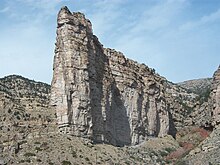HOW WERE THE MOUNTAINS MADE?
Because mountains are so big and grand, man thinks of them as unchanging and everlasting.But Gelolgists,the scientists who study mountains,can prove that mountains do change, and that they are not everlasting.
Certain changes in the earth's surface produced the mountains , and they are constantly being destroyed and changed. Boulders are broken from mountain sides by freezing water; soil and rock particles are carried away by rainwash and streams.In time, even the highest mountains are changed to rolling hills or plains.
Geologists divide mountains into four classifications , according to how they are formed. All mountains, however , are the result of violent changes in the earth's surface, most of which happened millions of years ago.
Folded mountains were made of rock layers, squeezed by great pressure into large folds. In many places in such mountains , you can see the rock layers curving up and down in arches and dips, caused by the sqeezing and pressure on the earth's surface.The Appalachian Mountains and the Alps of Europe are examples of folded mountains.
In dome mountains, the rock layers were forced up to make great pressure from below the earth's surface, lifted these rock layers.The Black Hills of south Dakota are examples of dome mountians.
Block mountains are the result of breaks,or faults, int earth's crust.Huge parts of the earth's surface, entire ''blocks'' of rock, were raised up or tilted at one time. The Sierra Nevada Range of Clifonia is a block that is 400 miles long and 80 miles wide!
Volcanic mountains are built of lave,ash, and cinders poured out from within the earth. The usual volcano is cone-shaped with a large hole, or crater, at the top. Among the famous volcanic mountains are Mounts Ranier, Shasta, and Hood in the United States, Fujiyama in Japan , and Vesuvius in Italy.
Many mountain ranges have been formed by more than one of the ways described. In the Rockies are mountains made by folding, faulting, doming, and even erosion of lava!



No comments:
Post a Comment